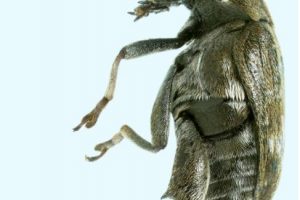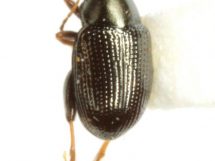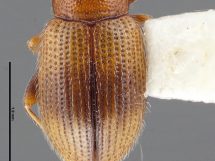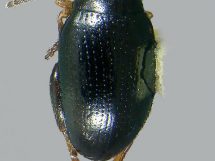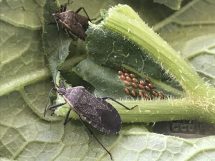THREE-LINED POTATO BEETLES
Occurrence: Active Now | Confirmed in Uintah County on Tomatillo Plants (Active May through August)
Description: Adult three-lined potato beetles are ¼ inch (7-8 mm) long and have an orange head and prothorax (segment behind head) with two black spots. Their femurs are orange, while the lower legs are darker. Three distinctive black stripes run lengthwise along their mustard-yellow wing coverings. Larvae are dark, greyish, and “slug-like.” They have three pairs of legs, along with a rounded black head. They cover themselves with their excrement as a probable defense to being eaten. Eggs are orange, ovular and laid in clusters on foliage. Adults feed individually, while larvae tend to destroy host plants in groups. Both stages are phytophagous, meaning they create holes within leaves or cause complete defoliation. This may reduce plant vigor, photosynthesis, and yield in tomatillos.
*Three-lined Potato Beetles should not be confused with Western Corn Rootworms, Striped Cucumber Beetles, or Colorado Potato Beetles
Management:
- Hand remove larva and place in soapy water (Home gardens)
- Remove nearby weeds (especially those in the nightshade family) as they can serve as an alternate host
- Row covers may be effective in excluding three-lined potato beetle adults when emerged in the spring
Examples of Potato Beetle Pesticide Products
| carbaryl | Garden Tech® Sevin 5% Dust Bug Killer |
| cyfluthrin | BioAdvanced® Vegetable and Garden Insect Spray |
| pyrethrins | Monterey® Bug Buster-OOB, Worry Free® Insecticide and MiticideB |
| pyrethrins + piperonyl butoxide | Bonide® Bon-Neem II |
| zeta-cypermethrin | GardenTech® Sevin |
| pyrethrins + canola oil | Espoma® Insect ControlB, Monterey Take Down Garden SprayB |
| pyrethrins + potassium salts of fatty acids (insecticidal soap) | Safer® Brand Tomato & Vegetable Insect KillerOB |
| pyrethrins + sulfur | Bonide® Tomato and Vegetable 3 in 1B, Natria Insect Disease & Mite ControlB, Ortho Insect Mite & Disease 3 in 1B |
| spinosad | Bonide® Captain Jack’s DeadbugB, Monterey® Garden Insect SprayOB |
| oil: mineral | Bonide® All SeasonsB, Safer® Brand Horticultural & Dormant OilOB |
PEA WEEVILS
Occurrence: Active Now | Confirmed in Cache County on Peas
Description: Adults are oval-shaped and measure 4.5-6mm long and 2 mm wide. They are brownish with patches of white, gray, and black. Legs and antennae are black. The larva develops through four instars growing from 1.5 mm to 6-7 mm long. In Utah, there is usually 1 generation of pea weevils per year. Adults overwinter in sheltered areas. When temperatures warm they become active (during the time peas bloom) and begin infesting pea plants. Eggs are laid on the green pods, larva feed by penetrating the pod and eventually the seed. After larval development, the weevil pupates within the pea seed itself. Damage caused by the pea weevil may be considered unmarketable for human consumption. Note- economic damage is very unlikely in Utah.
Management:
- Monitor for adult weevils and any feeding damage on the pea pods themselves.
- Remove pea residue at the end of the season to discourage overwintering.
FLEA BEETLES
Occurrence: Active Now | Present throughout Utah
Description: Adults typically range from 1/15 to 1/6 inch (1.7 to 4.2 mm) long. They have large hind leggs for jumping. Various species range in color from brown, green, metallic-blue to black; may have stripes or spots. Eggs are elliptical and half a millimeter long. Larvae are worm like with a white body and brown head. Most flea beetle species overwinter as adults in protected places such as under leaf litter, dirt clods, or on weeds along field borders and ditch banks. Adults become active in mid-to late spring and feed on weeds and other available plants. When their preferred host plants become available, and/or when weeds dry up, the adult flea beetle will move to nearby fields or vegetable gardens.
After several weeks of feeding, adults of most species of flea beetles begin laying eggs in the soil at the base of desirable host plants. Minute, worm-like larvae hatch and begin feeding on small roots and root hairs. For a few species of flea beetles that develop above ground, eggs are laid in masses on leaves or twigs and young larvae feed on leaves producing skeletonizing injury similar to other leaf beetles. The larval stage typically lasts about a month; then they pupate and emerge as the second generation of adults in late spring to mid-summer. A third generation may occur for some flea beetle species.
Flea beetle adults use visual and chemical olfactory (smell) cues to find host plants. They chew holes or pits into leaves and cotyledons. On plants with thinner leaves, such as mustard and potato, adult feeding causes small, rounded holes characteristically described as “shot holes” [1/16 to 1/8 inch (1.5 to 3.2 mm) in diameter]. On plants with leaves that are waxy and thick, such as broccoli, the injury appears as pitting.
Management:
The high mobility of flea beetles can make management more challenging. Understanding their biology and life cycle will help identify effective strategies and optimal timings to reduce their negative impacts. When management of flea beetles is warranted, a combination of cultural, physical, biological, and chemical options should be used.
- Scout plants for damage.
- Use sticky traps to monitor populations.
- Adjust planting times to avoid peak flea beetle activity.
- Promote healthy, fast-growing plants to minimize their vulnerability to flea beetles.
- Plant trap crops that are highly attractive to flea beetles (such as mustards).
- Companion plants can confuse, repel, or block insect pests from finding host plants.
- Remove old plant residue and nearby weeds as those can serve as alternate hosts.
- Row covers are used to cover plants to create a physical barrier against pest insects.
- Generalist predators such as larvae of lacewing, adult big-eyed bugs and damsel bugs feed on adult flea beetles.
Although the foliar application of insecticides is the most common management tactic for flea beetles, insecticides should only be used if necessary. Since plants produce continuous new growth and the highly mobile beetles can rapidly reinvade plantings, insecticides may have to be applied more than once to cover the plant’s susceptible period.
Examples of Home-Use Pesticide Products Labeled for Flea Beetle Control
| carbaryl | Garden Tech® Sevin 5% Dust Bug Killer |
| malathion | Spectracide® Malathion, Ortho Malathion |
| bifenthrin | Hi-Yield® Vegetable & Ornamental Insect Control, Fertilome® Broad Spectrum Insecticide |
| gamma- cyhalothrin | Spectracide® Triazicide |
| cyfluthrin | BioAdvanced® Vegetable and Garden Insect Spray |
| pyrethrins | Monterey® Bug Buster-O, Worry Free Insecticide and Miticide |
| pyrethrins + piperonyl butoxide | Bonide® Bon-Neem II |
| zeta-cypermethrin | GardenTech® Sevin |
| pyrethrins + canola oil | Espoma® Insect Control, Monterey Take Down Garden Spray |
| pyrethrins + potassium salts of fatty acids (insecticidal soap) | Safer Brand® Tomato & Vegetable Insect KillerOB |
| pyrethrins + sulfur | Bonide® Tomato and Vegetable 3 in 1, Natria® Insect Disease & Mite Control, Ortho® Insect Mite & Disease 3 in 1 |
| zeta-cypermethrin | GardenTech® Sevin |
| azadirachtin | Safer® BioNeem |
SQUASH BUGS
Occurrence: Active Now | First generations active across Utah (mating and egg-laying)
Description: Squash bugs are the primary pest of cucurbit crops, and can kill plants. They feed with a piercing-sucking mouthpart, removing large amounts of plant sap. In Utah, they do not vector plant diseases.
Adults are 5/8-inch long with wings folded over a flat back. They emit a foul odor when disturbed and some people call them “stink bugs”; however, true stink bugs are in a different insect family. There are five nymph squash bug stages (immatures), that range in color from reddish to green-gray.
Squash bugs spend the winter as adults in protected sites under plant debris, compost piles, around building foundations, etc. They emerge in spring, typically during April in southern Utah and during May in northern Utah. They fly to host plants to feed, mate, and lay eggs. Each female lays up to 250 clusters of 4-40 eggs on the undersides of leaves. The eggs hatch into nymphs that take 4 to 6 weeks to mature into adults. The summer generation of adults appears in late July in northern Utah (3 to 4 weeks earlier in southern Utah), and feeds on cucurbit hosts while they build up fat reserves to survive the winter.
Management:
- Mechanical Destruction. Hand-picking adults and nymphs, and smashing egg clusters on leaves can reduce squash bug populations. Options to remove eggs include cutting them out of the leaf, sticking them to duct tape rolled around the fingers, or smothering them with oil or petroleum jelly. Mechanical destruction will be most successful if started early in the season and done every 2-3 days.
- Minimize populations of overwintering adults. After harvest, till or remove cucurbit crop debris (including vines and fruits). Remove woodpiles, plastic mulch (or other synthetic ground covers), and ground debris near fields where insects may seek protection for the winter.
- Resistant Varieties. Plant squash varieties that are more tolerant of squash bug feeding than others. Resistant: Butternut, Royal Acorn. Moderately resistant: Sweet Cheese, Green Striped Cushaw. Susceptible: Pink Banana, Black Zucchini. Highly susceptible: Yellow Squash, Hubbard, Pumpkins.
- Crop Rotation. Rotate to non-cucurbit crops in alternating years to reduce the number of immigrating adult squash bugs. Crop rotation will be most effective in larger fields.
- Timing of Planting. Peak egg-laying by adult squash bugs typically occurs in late May in northern Utah and in late April to early May in southern Utah. Seed or transplant before or after this timing to reduce potential injury.
- Homemade Traps. During the growing season, trap adults and nymphs seeking protection by using wooden boards, shingles, and heavy cardboard placed on the ground next to host crops. Squash bugs will tend to aggregate under the traps at night. In the early morning, turn the boards over and destroy the bugs.
- Mechanical Destruction. Hand-picking adults and nymphs, and smashing egg clusters on leaves can reduce squash bug populations. Options to remove eggs include cutting them out of the leaf, sticking them to duct tape rolled around the fingers, or smothering them with oil or petroleum jelly. Mechanical destruction will be most successful if started early in the season and done every 2-3 days.
- In general, mulches (particularly plastics) can harbor squash bugs and are not recommended. However, mulches (straw, wood chips, paper, etc.) suppress weeds, attract beneficial insects, and reduce soil moisture loss. Therefore, the numerous benefits may outweigh the negatives.
- Trap Crops. Trap crops are cucurbit cultivars that are attractive to adult squash bugs. Several weeks before planting the main cucurbit crop, plant the trap crop along field borders or interspersed as clumps throughout the field. Target squash bugs by applying an insecticide or destroying the trap crop before eggs begin to hatch to reduce damage to the later-maturing main crop. Hubbard squash is a common trap crop used.
- Natural Enemies. The most common natural enemies of squash bugs are parasitoids. These include a tachinid fly, Trichopoda pennipes whose larvae feed on older nymphs and adults, and several wasps that parasitize eggs in the family Encyrtidae and Scelionidae.
Examples of Home-Use Pesticide Products Labeled for Squash Bug Control
| pyrethrins | Monterey® Bug Buster-O, GardenTech® Worry-Free |
| Pyrethrins + sulfur | Bonide® Tomato and Vegetable 3 in 1, Ortho® Insect Mite & Disease 3 in 1 |
| Zeta-cypermethrin | GardenTech® Sevin |
| Permethrin | Bonide® Eight Garden Dust |
Commercial growers can reference product recommendations here.
To be effective, insecticide sprays must penetrate the plant canopy and thoroughly cover the top and underside of leaves, fruits, and vines. Apply insecticides in the early morning or late evening when sprays will dry more slowly and result in better coverage of the vegetation. In the morning hours, the leaf position may be more upright and allow for better coverage of leaf undersides. Don’t spray during the day when plants are blossoming to avoid harming pollinators.








